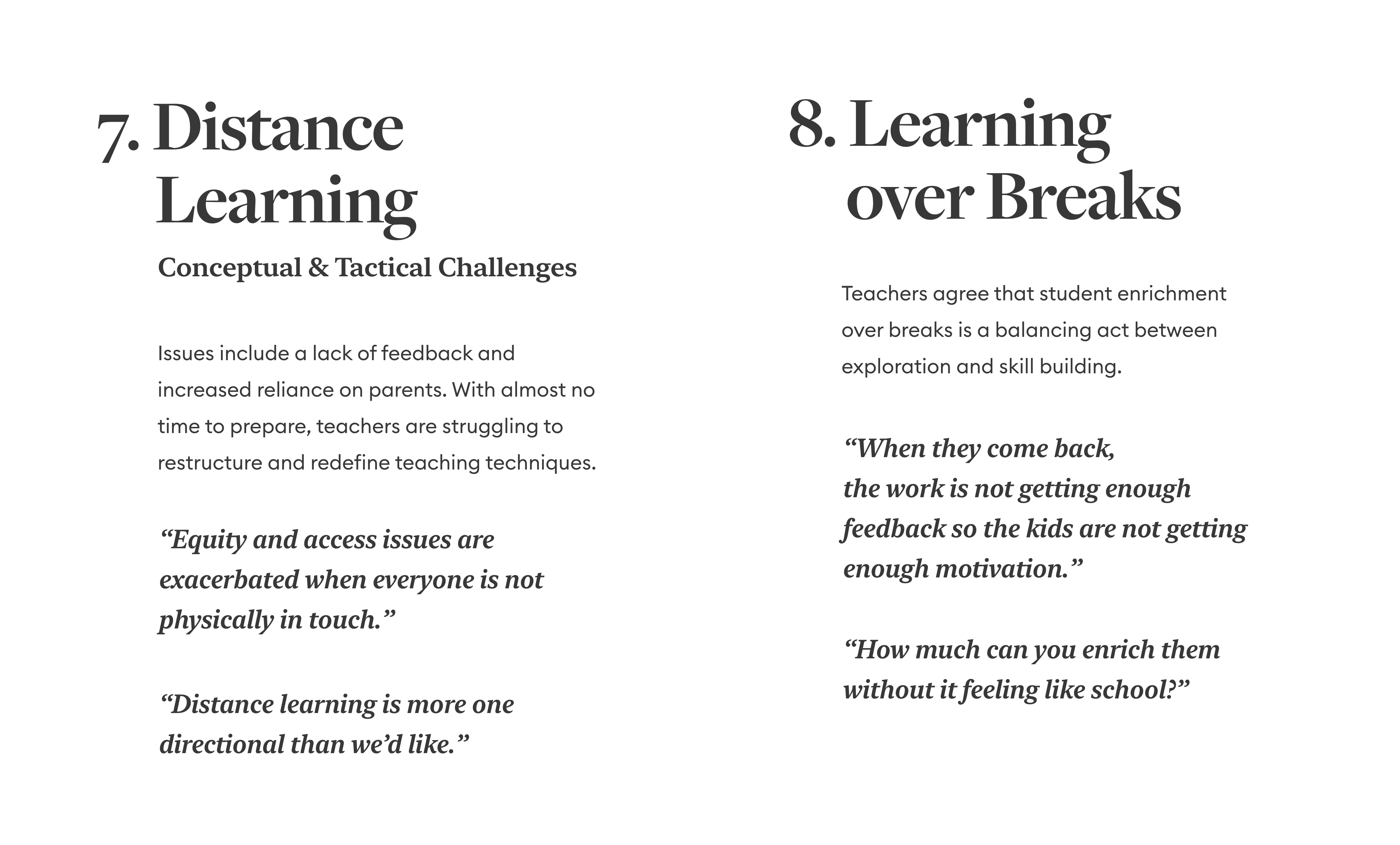Reimagining the year-round calendar to improve academic equity for New School.
The New School of San Francisco is a tuition-free K-12 charter school, currently serving K-6. At the heart of New School’s approach to education are the core values of inquiry, equity, and personalized learning. 50% of New School families qualify for free or reduced lunch and come from varying socio-economic backgrounds.
We partnered with New School as a part of our Social Lab project to explore how time impacts academic equity– specifically the impact of a year-round academic calendar.
My Role
I teamed up with a group of graduate students in the MDes Interaction Design program at California College of the Arts. We collectively made decisions and steered the project direction.
I was involved in initial partner communication, setting up collaboration tools such as Notion, aligning project scope, guiding the research process and performing extensive research, ideation, wireframing and system mapping.
Duration
6 months - Feb to July 2020
Team Members
Advisors
POC at NSSF
Shernice Lazare

The Challenge
The traditional year-round calendar is structured with long breaks, especially around summer. This leads to a phenomenon called the ‘summer slide’. When students drop off academically over the break, their academic progress is reversed due to a lack of continued learning and feedback from teachers. Students with limited access to opportunities like summer camp, outside education, or who have working guardians and less family flexibility are especially vulnerable to the summer slide.
We were approached by New School to reimagine the year-round calendar to alleviate summer slide and promote academic equity at the New School.

Our approach
We collaboratively decided upon our team values at the beginning of our partnership with the New School. Our team values represent how we approached each stage of the design process with the best interest of new school families at heart.

Project Outcome
We proposed a systemic change personalized to New school’s needs in the form of a balanced calendar paired with take home packages to support learning during breaks.
Part 1 : Balanced calendar
The balanced calendar is a modified year-round calendar with a series of evenly distributed breaks throughout the school year, resulting in a shorter summer break. We proposed a balanced calendar based on New School’s learning arcs specific to the needs of the New School families.
Part 2 : A take home package framework
The calendar redesign does not end with redistributed breaks. The second part of this project focuses on exploring ways to effectively use the break time to supplement student learning with the help of intersessions and take-home packages.
With the onset of covid, the take home packages were adapted to administer remote learning to New School students as education turned online.
The process
To kickoff our partnership with the New School of San Francisco, we crafted a project plan. Even though we considered smaller alterations and contingencies throughout the plan, nobody expected COVID. As we proceeded, we were challenged to adapt to the correct balance between following a decided plan and real-time adaptation. The process steps are illustrated below.


Research
We conducted extensive primary and secondary research to gain an in-depth understanding of the domain, our stakeholders, and their goals and needs. Our research was primarily divided into the following methods–

Explore below to know more about our research methods and findings. To view the entire research report click here.














Adapting to remote collaboration
With the onset of Covid in March, we had to shift our collaboration completely online. The seemingly difficult did not stop us from pushing forward with our project. We quickly adapted to the unprecedented situation and continued our research and synthesis online with the help of digital collaboration tools like Miro and Figma.
Remote collaboration made our work even more structured and organized. We came up with creative ways of synthesizing the collected research data digitally.

Synthesis
Identifying key themes
Our research data was rich in findings which we clustered together to form key themes. Using affinity mapping, we sorted the quotes into themes for each stakeholder group. Common themes began to emerge across stakeholder groups, which eventually led us to our four main insights. Explore below to view key themes for all stakeholder groups.







Insights
1. Academic Equity
An effective approach to academic equity that represents New School’s principles of autonomy and agency should be based on choice and flexibility, instead of imposition.
2. Learning Over Breaks
Varying expectations about vacation make it difficult for New School to implement a systematic approach to learning over breaks that incorporates enough feedback to benefit students.
3. Remote Learning
Inquiry based learning is inherently dependent on feedback. Without the physical environment of a school, teachers are redefining what it means to give and receive feedback.
4. Balanced calendar
The calendar redesign does not end with redistributing breaks. It should also be focused on exploring ways to effectively use the break time to supplement student learning.
How might we extend New School’s approach of personalized learning into school breaks to improve academic equity?

Ideation
A two part approach
As highlighted in the insights section our research made two things clear :
1. Both staff and parents were open to the idea of a balanced calendar specific to New School’s learning arcs.
2. Migration towards a balanced calendar meant that there was a need to effectively utilize the 'break time' to supplement student learning.
This led to our focus on not just a balanced calendar but a personalized take-home package with it to support remote learning with a built-in feedback system.


Our Proposal
The Balanced Calendar
We proposed a balanced calendar, based on New School’s learning arcs by redistributing the in-school time to chunks of 8, 9, 10 and 11 weeks respectively with in between breaks of fall (1week) , winter (3weeks), spring (2weeks) and summer (6weeks). Each in-school time chunk is further divided into 2 learning arcs.

This phase included multiple iterations and co-creation with our partner Shernice and other staff at New School to understand these learning arcs and to best reimagine the calendar based on existing breaks.

The calendar would be available on the New School website and can be viewed across devices. We also proposed a google calendar integration and collaborated with New School further to envision an onboarding process where the calendar would be shared at the beginning of each school year.
The take home package framework
The second part of our solution is a take-home package system where personalized packages are handed over to New School students during break time to supplement their learning experience. Each take-home package includes targeted learning resources based on the student’s grade level and performance, reading materials (such as books and printed worksheets), and basic stationery.

With the onset of covid education at New School turned online. We proposed a new system to adapt the take-home packages to administer remote learning to New School students during these unprecedented times.
Teachers prepared bi-weekly learning materials and the packages were made available for drive-through pickup to minimize in-person contact. The contents of the package helped supplement their daily zoom lessons. Students would share their progress online which helped teachers incorporate feedback to benefit the students while providing the necessary hands-on experience.

The New School of San Francisco will be implementing the Balanced Calendar for the academic year of 2021 - 2022.
The take-home packages were implemented during fall 2020 to assist remote learning due to COVID.
Next Steps
1. Communicating the balanced calendar to New School families
With New School planning to implement the balanced calendar for the academic year of 2021 - 2022, it is important to communicate New school’s approach and rationale behind this change to new and existing families. We tackled this in the next phase of our partnership with the New School by proposing a new onboarding process and communicating the balanced calendar as a part of it.
2. Refining and adapting the take-home package framework.
The take-home packages shared by New School during covid was an MVP. We further proposed the incorporation of personalized learning materials based on the student’s learning capabilities and performance. The personalized take-home packages need to be tested and the framework needs to be modified based on the feedback.
3. Co-designing in-person intersessions
Engagement with students during break-time would be two-part– with the help of take-home packages, and in-person intersessions for students with greater learning difficulties. As new school shifts to a balanced calendar, the next steps would be to co-create a working model of these in-person intersessions to supplement student learning during break time.
Reflections
Covid greatly affected our course of action with respect to the project focus. While the initial focus was to validate the need and thereafter shift towards a balanced calendar, research indicated that the problem was much bigger than that. We ended up proposing a framework for take home packages to supplement the balanced calendar as an additional part of this project.
This project taught me that even when you are working with a client, here our partner the New School of San Francisco, it is important to always keep in mind the needs of the end users (the staff and the families).
We also adapted to remote collaboration and leveraged creative research and synthesis methods to accommodate remote participants. The whole process has taught me much about adapting to change with a positive outlook.
Thanks for getting this far. Here is a little bit of motivation for you!
©2020 Monica Poddar | Made with lots of love and Kombucha in San Francisco, CA.
